You may have heard the term fusion splicing before but what exactly is it?
In this section we talk about the different methods of joining optical fibres, but first we explain why it is necessary to join them. We then explain how a fusion splicer works and why it is a preferred method of joining optical fibre.
Why do we join fibres?
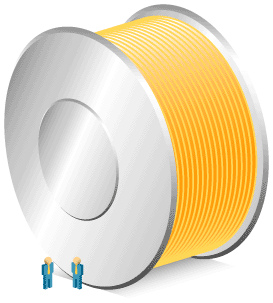
Optical fibre can be used to carry information across long distances (such as a transatlantic high bandwidth connection for a telecommunication network).
It also can be used to provide data connections in local area networks or closed circuit TV links. It is just not feasible to produce 7,000 kilometres of fibre in one reel, or even a bundle of fibres pre-cut to length for an office installation.
The only efficient method in which this incredibly flexible product can be used is by cutting and joining lengths together to suit the various requirements of each application.
How do we join fibres?
One critical factor when looking at the alternative fibre jointing technologies is how much light is lost at each joint. Light loss is measured in decibels (dB) – a decibel is 10 times (hence “deci”) the logarithm of the fraction of light lost in the joint. Decibels are used because you can simply add the dB losses of each joint together to find out the overall loss in a system. There are basically two types of connection for optical fibre – demountable (connectors) and permanent (splices).
Connectors

Connectors are used when connecting to the end equipment (the transmitters and receivers). The system can then be disconnected or reconfigured. Typically, the losses when using connectors are 0.15 dB – 0.50 dB. Connectors can also be used in temporary fibre-to-fibre connections.
Mechanical Splicing
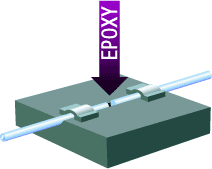
Splices are used to permanently join two lengths of optical fibre together, or often to attach connectorised leads (called pigtails) to the ends of installed fibre runs. One method is known as mechanical splicing, where a mechanical jig (with a ferrule or a v-groove) is used to align and butt the fibres together, and hold them permanently in place. Index matching fluid can be used to reduce the boundary reflections between the two fibres. Losses with mechanical splicing are typically 0.10 dB – 0.25 dB.

But the most popular way to make a permanent joint is known as fusion splicing…
What is fusion splicing?

Fusion splicing is used when a permanent, stable joint is required.
In fusion splicing, the fibres are accurately aligned in a machine called a fusion splicer, and then a precisely controlled high voltage electric arc is used to melt and fuse the two fibres together.
This produces a homogenous joint as the boundary between the two fibres is removed with very little light lost at the joint.
Typically, losses with a fusion splicer are between 0.02dB and 0.15dB.
Why do we use fusion splicing?
Fusion splicing is used when a permanent, stable joint is required.
In fusion splicing, the fibres are accurately aligned in a machine called a fusion splicer, and then a precisely controlled high voltage electric arc is used to melt and fuse the two fibres together.
This produces a homogenous joint as the boundary between the two fibres is removed with very little light lost at the joint.
Typically, losses with a fusion splicer are between 0.02dB and 0.15dB.
Why do we use fusion splicing?
A fusion splice:
– is a very low loss joint (typically 0.05 dB compared to 0.2 dB for a mechanical splice)
– is very stable because of the homogeneous joint formed by the fusion process
– has very little reflected light (high return loss) because the boundary between the two fibres has been removed
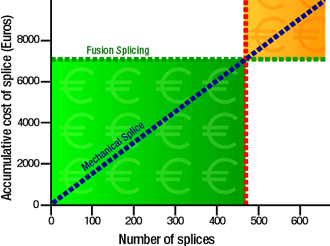
– has a low consumable cost – Although there is a relatively large capital commitment to acquire the splicing unit, the cost per splice is negligible. This is because the only consumables during the fusion splicing process are cleaning materials and heatshrink splice protectors. The much higher cost per splice of a mechanical splice means that after about 500 splices the capital cost of a fusion splicer has been recovered.
Why is preparation critical?
As the key to splicing a good fibre joint is the alignment of the fibre core, it is imperative that there is no dirt or dust on the fibre before it is introduced to the v-groove of the splicing machine. Therefore, cleaning the fibre with a solvent such as alcohol is essential.
Secondly, in order to splice the two fibres accurately, you need two straight vertical ends to align. This is why the optical fibre cleaver is used.
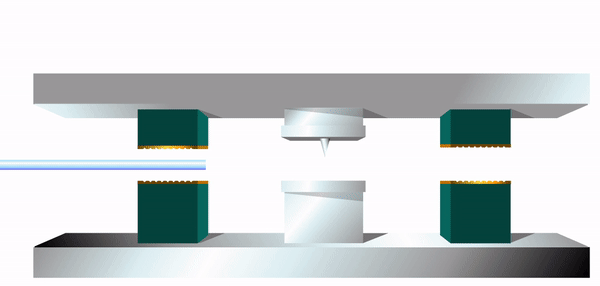
A cleaver must clamp and tension a fibre over an anvil without inducing any torsion so that when a diamond blade is lowered onto the surface of the fibre a crack propagates at 90° to the fibre producing a flat square end.
Tritec previously produced the TCA8 and TC II+ cleavers.
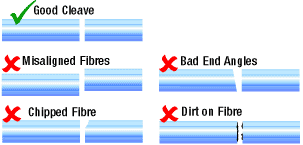
All protective coatings must be stripped from the fibre prior to cleaving. As there are many different cable designs to protect the fibre, a range of specialist hand-tools is essential.
Tritec previously produced the FPK I fibre preparation kit.
How is a spliced joint protected?
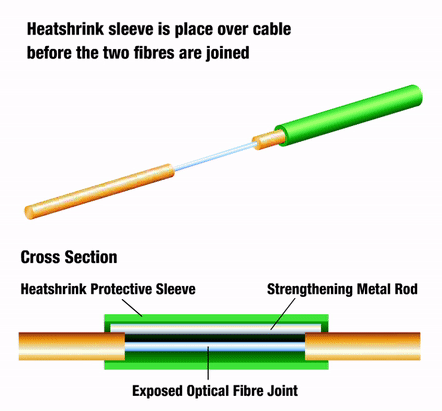
Once the fusion splice is complete 20 – 40 mm of bare fibre will be left exposed. This region is vulnerable to breaking and needs protecting.
An optical fibre splice protector has plastic coating made of a heatshrink material (typically 2.5mm in diameter and 60mm long) with a stainless steel rod placed inside it.
To protect the spliced joint, the sleeve is positioned over the joint, and is then placed on the heating element of a heatshrink oven.
This oven is designed to heat the sleeve from the centre outwards to avoid trapped air bubbles. It also supports the sleeve preventing bending during the protection process.
Tritec previously produced the HSO II oven.
Installation is required in many different environments. Within an office there could be an enclosure on a wall, or externally down a manhole. A joint enclosure provides further protection when cables are joined to each other. The enclosure should protect the spliced and protected fibres from rain or dust, and also provide storage for excess fibre. Splice trays within the joint enclosure are often used for this storage, particularly when the fibre count in a cable is high.
See our other FAQ sections: What is Optical Fibre? and What is FASE?
 Tritec
Tritec